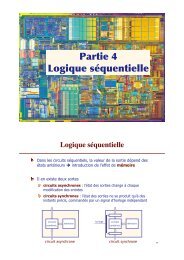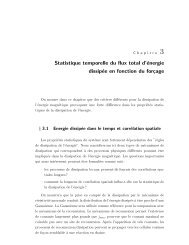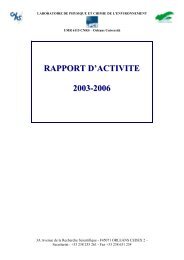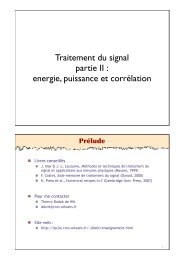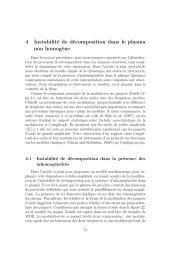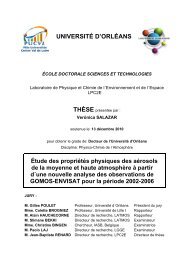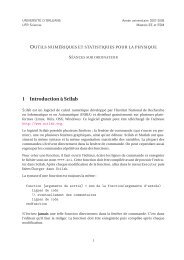UNIVERSITÉ D'ORLÉANS - Laboratoire de physique et chimie de l ...
UNIVERSITÉ D'ORLÉANS - Laboratoire de physique et chimie de l ...
UNIVERSITÉ D'ORLÉANS - Laboratoire de physique et chimie de l ...
You also want an ePaper? Increase the reach of your titles
YUMPU automatically turns print PDFs into web optimized ePapers that Google loves.
More evi<strong>de</strong>nce for very short-lived substance contribution to stratospheric<br />
chlorine inferred from HCl balloon-borne in situ measurements in the<br />
tropics<br />
Y. Mébarki, V. Catoire, N. Hur<strong>et</strong>, G. Berth<strong>et</strong>, C. Robert and G. Poul<strong>et</strong><br />
<strong>Laboratoire</strong> <strong>de</strong> Physique <strong>et</strong> Chimie <strong>de</strong> l’Environnement <strong>et</strong> <strong>de</strong> l’Espace (LPC2E), UMR 6115<br />
CNRS–Université d’Orléans, 45071 Orléans ce<strong>de</strong>x 2, France<br />
Correspon<strong>de</strong>nce to: V. Catoire (Valery.Catoire@cnrs-orleans.fr)<br />
Abstract<br />
Volume mixing ratio (vmr) vertical profiles of hydrogen chlori<strong>de</strong> (HCl) are r<strong>et</strong>rieved from in<br />
situ measurements performed by a balloon-borne infrared tunable dio<strong>de</strong> laser absorption<br />
spectrom<strong>et</strong>er (SPIRALE) during two balloon flights in the tropics (Teresina, Brazil, 5.1°S–<br />
42.9°W) in June 2005 and June 2008. HCl vertical profiles obtained from 15 to 31 km are<br />
presented and analysed to estimate the contribution of very short-lived substances (VSLS) to<br />
total stratospheric chlorine. Both r<strong>et</strong>rieved vertical profiles of HCl from these flights agree<br />
very well with each other, with estimated overall uncertainties of 6% on vmr b<strong>et</strong>ween 23 and<br />
31 km. Upper limits of HCl vmr as low as 20 pptv in June 2008 and 30 pptv in June 2005 are<br />
inferred in the upper part of the tropical tropopause layer (TTL). Backward trajectory<br />
calculations and such low amounts suggest that the air masses sampled correspond to typical<br />
background conditions, i.e. neither influenced by recent tropospheric nor stratospheric air.<br />
Taking into account the recently reported VSL source gas measurements obtained in similar<br />
conditions (Laube <strong>et</strong> al. 2008) and the main intermediate <strong>de</strong>gradation product gas COCl2 (Fu<br />
<strong>et</strong> al., 2007), a total VSLS contribution of 85±40 pptv to stratospheric chlorine is inferred.<br />
This refines the WMO (2007) estimation of 50 to 100 pptv, which was not taking into account<br />
any HCl contribution. In addition, comparisons of HCl measurements b<strong>et</strong>ween SPIRALE and<br />
the Aura MLS satellite instrument in the tropical lower and middle stratosphere lead to a very<br />
good agreement. The previous agreement b<strong>et</strong>ween MLS-<strong>de</strong>duced upper stratospheric total<br />
chlorine content and mo<strong>de</strong>lled values including 100 pptv of VSLS (Froi<strong>de</strong>vaux <strong>et</strong> al., 2006) is<br />
thus supported by our present result about the VSLS contribution.<br />
110



